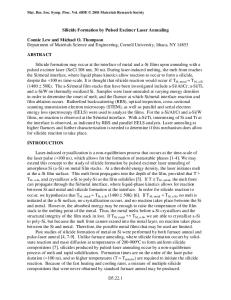Infrared Semiconductor Laser Annealing Used for Formation of Shallow Junction
- PDF / 138,307 Bytes
- 6 Pages / 612 x 792 pts (letter) Page_size
- 1 Downloads / 382 Views
1070-E03-04
Infrared Semiconductor Laser Annealing Used for Formation of Shallow Junction Toshiyuki Sameshima1, Yuta Mizutani1, Naoki Sano2, and Masao Naito3 1 Tokyo A&T Univ., Koganei, 184-8588, Japan 2 Hightec Systems Corporation, Yokohama, 222-0033, Japan 3 Nissin Ion Equipment Co., Ltd., Koka, Japan
ABSTRACT We report continuous-wave (CW) infrared-semiconductor laser annealing of silicon implanted with boron atoms with assistance of diamond-like carbon (DLC) films as optical absorption layer in order to form shallow junctions. Boron ions were implanted at 10 keV at concentrations 5x1014, 1x1015 and 2x1015 cm-2. Boron clusters were also implanted at 30 and 6 keV at 1x1015cm-2. The samples were coated with 200-nm-thick DLC films and annealed by irradiation with a 940 nm CW laser at 70 kW/cm2 with a beam diameter of 180 µm for a dwell time of 2.6 ms. The boron in-depth concentration profiles hardly changed from the initial profiles because of rapid heat treatment. The effective doping depths at 1x1018 cm-3 were 203, 45 and 7 nm for implantation of samples implanted with boron atoms at 10 keV, boron clusters at 30 and 6 keV, respectively. The free carrier photo absorption analysis revealed complete activation of boron atoms implanted with boron clusters. Shallow doping was achieved by the present method.
INTRODUCTION Rapid heating is important for activating semiconductor materials implanted with impurity atoms. A high activation ratio and no marked impurity diffusion are required to fabricate extremely shallow source/drain extension (SDE) region with depth of 10 nm order in metaloxide-semiconductor (MOS) transistor devices for 45-nm-node and beyond, which cannot be realized by conventional rapid thermal annealing (RTA) [1-4]. Flash lamp annealing (FLA) or laser spike annealing (LSA) for several milliseconds and excimer laser annealing for the order of nanoseconds have been developed [2-4]. We have also developed an annealing method on the order from 10-5 to 10-3 s using infrared lasers [5-7]. Infrared semiconductor lasers are an attractive light source because they can have a high power ~10 kW, a high conversion efficiency ~50% and a stable emission. We use a carbon optical absorption layer in order to solve the problem of the low optical absorbance in infrared regions for silicon. Black carbon layers have a high optical absorbance in an infrared range because of a high extinction coefficient and a low refractive index giving a low reflection loss. A high thermal durability to a temperature around 5000 K enables the carbon layers to act as a heat source to the underlying silicon substrates to be annealed at a high temperature [8]. In this paper, we report annealing of silicon implanted with boron atoms using infrared semiconductor laser. We demonstrate an effective activation and a low electrical resistance by the free carrier optical absorption analysis. We also report that initial boron in-depth profiles are not significantly changed by laser annealing.
EXPERIMENTAL PROCEDURE The ion implantation was conduct
Data Loading...










